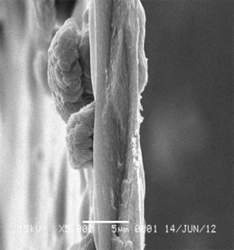Application of composite membrane from chitosan-cellulose diacetate-TiO2 for waste detergent treatment
DOI:
https://doi.org/10.11113/mjfas.v10n3.264Keywords:
chitosan, cellulose diacetate, composite membrane, TiO2, detergentAbstract
The synthesis of composite membrane from chitosan, cellulose diacetate and TiO2 as well as its application for waste detergent treatment were described here. Chitosan was synthesized from small crab shell using a chemical process involving deproteination, demineralization, depigmentation and deacetylation steps. Cellulose diacetate was synthesized from banana kepok using pulping, bleaching and acetylating steps. The production of composite membrane using inversion phase method by varying the concentration of cellulose diacetate 2%, 4%, 6%, 8% and 10%. The optimum mechanical properties of composite membranes were carried out with concentration variation of TiO2 0.1% 0.15%, 0.20%, 0.25% and 0.30%. The produced composite membranes of chitosan - cellulose diacetate - TiO2 were characterized by its thickness, performance, mechanical, morphology and were applied to waste detergent treatment. The results showed that the increasing of the concentration of cellulose diacetate made the composite membrane were more porous so the flux increases and the greater concentration of TiO2, the greater mechanical properties of the composite membranes. The optimum composite membrane was obtained with the concentration of chitosan 3%, cellulose diacetate 4% and TiO2 0.3%, thickness of 0.01 mm, flux of 1099.95 L/m2.day, rejection of 97.70%, stress at 0.0225 kN/mm2, strain at 0.3906, Modulus Young of 0.0576 kN/mm2 and can be applied to waste detergent treatment process with flux 832.93 L/m2.day and rejection of 95.39%.
________________________________________
GRAPHICAL ABSTRACT

References
Watkins, C., Surfactan and Detergent, All Eye Are on Texas, Inform 12 (2001) 1152.
Lara-Martín, P. A., Gómez-Parra, A., Köchling, T., Sanz, J. L., Amils, R., and González-Mazo, E., Environ. Sci. Technol., 41 (2007) 3573.
Doan, H. D., and Saidi, M., J. Hazard Mater., 158 (2008) 557.
Schleheck, D., Netzer, F. V., Fleischmann, T., Rentsch, D., Huhn, T., Cook, A. M., and Kohler, H. P., Appl. Environ. Microbial., 76 (2010) 196.
Duman, O., and Erol A., J. Hazard Mater., 174 (2010) 359.
Majewska-Nowak, K., Kowalska, I., and Kabsch-Korbutowicz, M., Desalination, 198 (2006) 149.
Boricha, A. G., Murthy, Z. V. P., Chem. Eng. J., 157 (2010) 393.
Wafiroh, S., Adiarto, T., and Kanserastiwi, G., Proceeding ICORAFF, UTM, Johor Bahru, Malaysia (2009) 100.
Wafiroh, S. Hamami, and Febriana, N., Proceeding The 2nd International Conference on Chemical Sciences, UGM, Yogyakarta (2010).
Wafiroh, S., Abdulloh, and Humairo, F, Proceeding ICOWOBAS 3rd International Conferences and Workshops on Basic and Applied Sciences, Airlangga University, Indonesia (2011).
Mistry, B., Handbook of Spectroscopic Data: Chemistry - UV, IR, PMR, CNMR and Mass Spectroscopy, Oxford Book Company, ISBN: 8189473867, 14416608529 (2009).
Gorri, Daniel., Raquel, Ib´a˜nez., da Ortiz, and Inmacula., J. Compos. Membr. Sci., 280 (2006) 582.
Baker, R. W., Composite Membrane Technology and Application, 2nd ed., John Wiley & Sons Ltd., Chichester (2004).
Mulder, M., Basic Principles of Membrane Technology, 1st ed., Kluwer Academic Publisher., Netherlands (1996).
Bilmeyer, F.W., Textbook of Polymer Science, John Wiley and Sons, New York (1962).



















